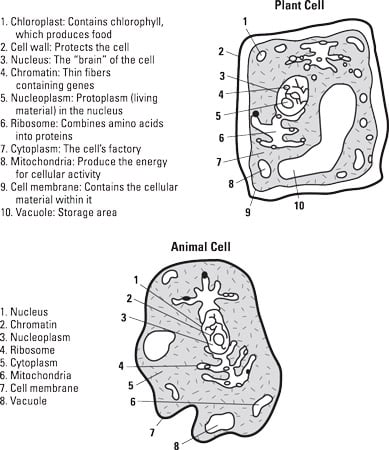You will need to know some basic information about cells for the ASVAB. Living things are made up of cells that share certain characteristics. Cells come in different sizes and shapes, depending on what they do. In the human body, a muscle cell looks very different from a brain cell. (Has all this talk of cells caused your brain cells to hurt yet?) Cells combine to create tissues, which form structures like bones and skin.
Looking at cell structure
A cell has three main parts — the nucleus, the cytoplasm, and the cell membrane:
Nucleus: The nucleus controls cellular activity. It’s like the brains behind the cell, and it holds the cell’s genetic material, such as DNA.
Bacteria are prokaryotes, which means their cells don’t have nuclei. Their genetic material floats in the cytoplasm instead of being held inside a membrane (nuclear envelope).
Cytoplasm: The cytoplasm is a gel-like substance, composed mostly of water, that’s inside the cell membrane and outside the nucleus. Cytoplasm contains many chemicals that carry out the life processes in the cell.
Cell membrane (plasma membrane): This thin membrane holds the cell together, protecting the nucleus and cytoplasm.
Plant cells differ from animal cells in several ways:
Plant cells have a firm cell wall that supports and protects the cell. Animal cells don’t have such a structure.
Plant cells have larger vacuoles (storage areas) than those found in animal cells.
Unlike animal cells, many plant cells contain chloroplasts, which contain chlorophyll, a chemical that helps plants create food with the help of sunlight.
Animal cells contain centrioles (cylindrical structures involved in cell division). Most plant and fungus cells don’t.
Animal cells have lysosomes (sacs of enzymes), which aren’t found in plant cells.
 Basic structures of plant and animal cells.
Basic structures of plant and animal cells.
Profiting from cell processes
Cells perform various processes to function at an optimum level. Here are a few of these processes:
Metabolism: Chemical processes within a cell that are necessary for life to be maintained
Osmosis: Movement of water through the cell membrane
Phagocytosis: Acquisition of particles of material from outside the cell; it’s accomplished by surrounding the particles and passing them through the cell membrane
Photosynthesis: Conversion of carbon dioxide and water into glucose and oxygen (in plants); in other words, sunlight is used to create energy
Cellular respiration: Process in which food is broken down, producing energy

